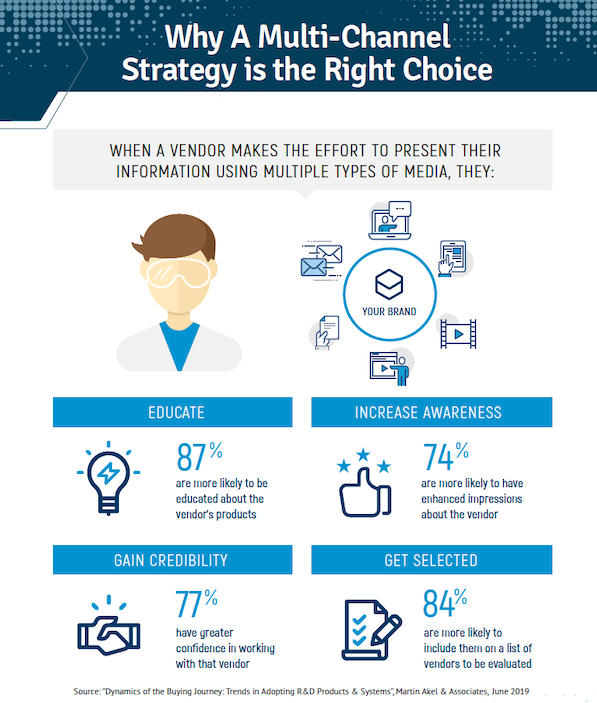Branding initiatives build awareness and positive associations for your company, products, and services. And while it’s true that sales teams are always clamoring for more leads, branding efforts are equally important because branding makes lead generation easier and more efficient.
Without the support of branding to keep your name top of mind with potential customers, lead-generation programs are forced to perform too much heavy lifting. With the support of branding, your company gains advantages that can help win business:
- Instilling in customers a sense of trust in your company.
- Customers prefer to buy from brands they know and trust. It reduces the fear and risk involved in making a purchasing decision. There’s some truth to the old adage: “No one ever got fired for buying from IBM.”
- Discoverability early in the scientist’s buying cycle, which is essential because most buyers prefer to search and research independently before contacting a potential vendor.
Data from a recent Biocompare study support these branding claims. When buyers are evaluating vendors on Biocompare, 78% are likely to investigate companies they haven’t yet had contact with but who they’ve come to know due to the vendor’s branding efforts on Biocompare. Conversely, only 40% are likely to investigate companies they’ve never heard of.
In addition, a survey by McKinsey and Company, reported in Forbes, found that decision makers for B2B purchases consider brand as a central rather than a marginal element of a supplier’s value proposition.
How Much Branding?
We believe both branding and lead generation should be part of your marketing portfolio. According to research conducted by LinkedIn, B2B organizations allocate 45% of their marketing budgets, on average, to branding.
These branding efforts are typically:
- Longer-term campaigns (typically more than six months)
- Focused on gaining visibility in the market
- Laying the groundwork for future business opportunities
What Channels for Branding?
There are two primary factors that affect brand awareness: reach and regularity.
Reach is how far and wide your marketing presence extends. Depending on your strategy, you may be using marketing programs to penetrate deeply into your current markets and core customers, get your message out to new markets and new potential customers, or some combination of these two strategies.
Regularity is how often your brand and message are visible to your target audience. Are you maintaining a consistent and highly visible presence, or only periodically appearing in the market to support specific initiatives?
Ideally, you want to maintain some level of visibility at all times in the market, and bump up your presence to a higher level to support product launches, important company milestones or news, or in response to a unique market opportunity.
Suppliers that deploy their marketing message over multiple channels on Biocompare, such as product listings, email, eNewsletters, and webinars, will likely achieve greater branding success.
When vendors use multiple Biocompare channels and media to present their information to potential customers:
- 74% of buyers have enhanced impressions of the vendor
- 84% are more likely to include the vendor on their list of suppliers to be evaluated
- 71% are more likely to move through their buying process with the vendor more swiftly

What About ROI?
Increasing brand awareness takes time and therefore should be measured over time. The key is having trends point in your favor. If your results increase month over month and quarter over quarter, you’ll know that your brand is growing stronger.
Choose metrics such as reach and visibility, name recognition, trends in sales, or shortening of sales cycles. In calculating ROI, you could also allocate the costs of branding campaigns among your lead-generation efforts under the assumption that branding is assisting those programs.
Individual programs have their own related metrics that help you measure branding.
- Email metrics include number of emails sent, number opened, and number of clicks or other desired actions such as forwards.
- For display ads, visibility can be measured by impressions, which is the number of times your ads are seen. Clicks on display ads measure engagement with your content. These metrics hold true for e-newsletter sponsorships as well.
- On the product directory, the number of product detail page visits measures visibility, whereby clicks to your site or requests for quote measure further interest and engagement.
- For eBooks and webinars, the number of page visits to the gated content landing pages, in addition to form completions.
Combine Branding and Demand Generation
Look for opportunities to gain both branding and lead-generation benefits through integrated programs that increase visibility and motivate action from your audience. Examples include using digital ads to promote a foundation webinar that features an industry expert. Or running regular advertising in an industry e-newsletter in which you offer brand-sponsored educational content.